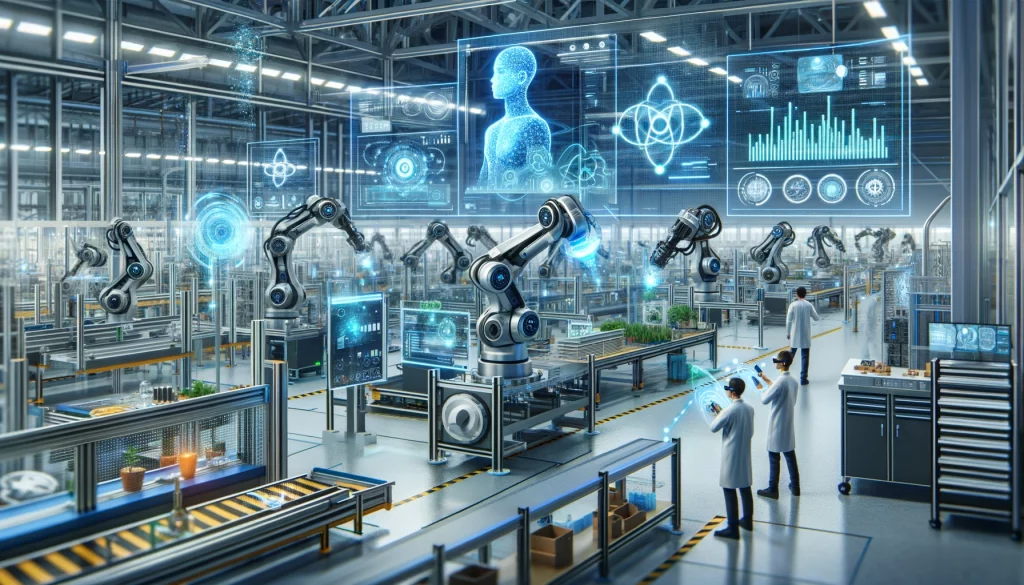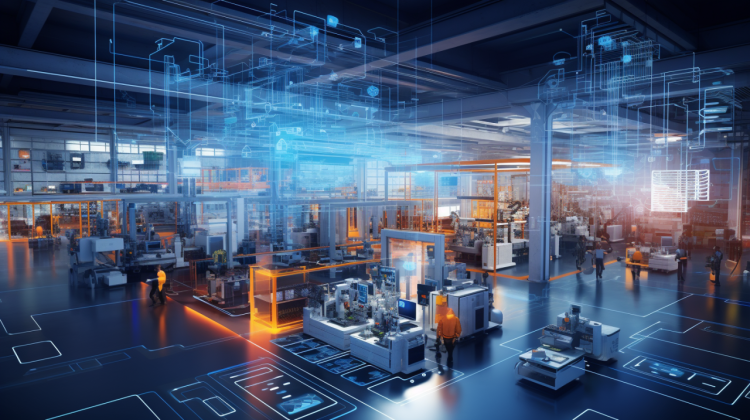Introduction
The rise of artificial intelligence (AI) and automation is revolutionizing industries across the globe. While these technologies promise to enhance productivity, reduce costs, and drive innovation, they also bring about significant shifts in employment structures. Jobs that once required manual labor, repetitive tasks, or human decision-making are increasingly being taken over by machines, algorithms, and AI-driven systems.
As these technologies continue to evolve, the nature of work will undergo profound changes. Some jobs will become obsolete, while others will transform into more complex roles that require new skills. In this article, we explore how AI and automation are reshaping employment structures across various sectors, and which industries are most likely to experience the most dramatic shifts in their workforce dynamics.
1. Manufacturing: The Shift from Labor-Intensive to Tech-Driven Work
1.1 Automation in Production Lines
The manufacturing industry has long been an early adopter of automation technologies. In fact, industries like automotive manufacturing were pioneers in integrating robots and automated systems into production lines. Today, AI-driven technologies and robotics are becoming even more advanced, with the potential to completely transform the sector.
- Traditional Jobs Replaced by Robots: In the past, manufacturing jobs required human labor to assemble, inspect, and package products. Now, robots and AI-powered systems can handle many of these tasks, often more quickly and efficiently than human workers. The widespread use of robotic arms, drones, and AI-based inspection systems is expected to reduce the need for assembly line workers, quality control inspectors, and material handlers.
- New Roles in Robotics and Maintenance: While many routine jobs are being automated, new roles are emerging to maintain, program, and repair these systems. Technicians skilled in robotics, AI, and machine learning will become crucial to keep automated systems running smoothly. In addition, the complexity of AI-driven manufacturing systems may require higher-level roles in data analysis, process optimization, and system integration.
- The Rise of Smart Factories: Industry 4.0, characterized by the integration of IoT, AI, and machine learning into manufacturing, is leading to the creation of “smart factories.” These factories use real-time data to monitor and optimize production processes, reducing downtime and increasing efficiency. As a result, workers will increasingly be required to manage and analyze data, operate complex machinery, and troubleshoot automated systems.
While automation and AI will reduce the need for certain manual labor roles in manufacturing, they will create new opportunities for tech-savvy workers capable of managing and maintaining sophisticated systems.
2. Retail: AI-Powered Personalization and Automation of Sales Roles
2.1 Automation in Customer Service
The retail sector is undergoing a major transformation due to AI and automation. Traditional customer service roles, such as cashiers, stock clerks, and customer service representatives, are increasingly being replaced by automated solutions.
- Self-Checkout Systems: Many retail stores, from supermarkets to electronics retailers, are implementing self-checkout systems that allow customers to scan and pay for their items without human assistance. These systems use AI to identify products, process payments, and detect errors, reducing the need for human cashiers.
- AI-Powered Chatbots and Virtual Assistants: Customer service chatbots powered by AI are becoming more sophisticated, handling a wide range of inquiries—from order tracking to returns processing. As these AI systems improve, the need for human customer service representatives will decline, particularly in roles that involve routine or repetitive inquiries.
- Personalized Shopping Experiences: AI is also enhancing the retail experience by offering highly personalized recommendations based on customer behavior, preferences, and purchase history. Retailers are using AI to improve product suggestions, optimize pricing, and even predict demand. This trend reduces the need for traditional sales associates while increasing the demand for data analysts and AI specialists who can develop and refine these systems.
While many entry-level retail jobs are being automated, the demand for workers skilled in data analysis, AI programming, and customer experience management is on the rise.
2.2 The Future of Warehousing and Logistics
AI and automation are also reshaping the warehousing and logistics industries, which traditionally employed large numbers of workers in physically demanding roles.
- Automated Warehouses: Robotics and AI are revolutionizing warehouses by automating tasks such as sorting, inventory management, and packaging. Amazon has been a leader in this transformation, using robots and AI-powered systems in its fulfillment centers. These robots can move products, package items, and even transport goods to delivery trucks, reducing the need for human labor in these roles.
- Delivery Drones and Autonomous Vehicles: The rise of autonomous delivery systems—such as drones and self-driving trucks—has the potential to significantly disrupt the logistics industry. These technologies could reduce the need for truck drivers and delivery personnel, although new jobs may emerge in managing and monitoring these autonomous systems.
- AI-Driven Supply Chain Optimization: AI is increasingly being used to optimize supply chain operations, from inventory forecasting to route planning. Workers with expertise in AI-driven logistics, data analysis, and supply chain management will become indispensable as businesses strive to improve efficiency and reduce costs.
While automation in warehousing and logistics will reduce the need for manual labor, new roles in AI systems management, drone operation, and supply chain analytics will emerge.
3. Finance: Automation and AI in Investment, Trading, and Risk Management
3.1 Algorithmic Trading and AI-Driven Investment
The finance sector is another industry where AI and automation are significantly altering employment structures. Algorithmic trading, robo-advisors, and AI-powered risk management tools are transforming how financial services are delivered, reducing the need for certain traditional roles.
- Robo-Advisors: Robo-advisors use algorithms to create and manage investment portfolios based on an individual’s financial goals and risk tolerance. This technology is disrupting the wealth management industry by providing low-cost, automated financial advice. While some roles in investment advising are being automated, there is still demand for human advisors who can offer personalized services to high-net-worth individuals or complex financial situations.
- Algorithmic Trading: AI and machine learning are increasingly being used in trading, enabling algorithms to analyze vast amounts of data and execute trades at speeds much faster than human traders. While traditional roles such as floor traders may become obsolete, new roles in algorithm development, data science, and quantitative analysis are emerging to support these AI-driven trading systems.
- Risk Management and Fraud Detection: AI systems are being employed to detect fraudulent activities, assess financial risks, and improve compliance. Machine learning algorithms can analyze transaction patterns to identify potential fraud, reducing the need for manual investigation. As a result, there will be greater demand for professionals who can develop and maintain these AI-driven risk management tools.
In finance, traditional roles in investment advising and trading are being replaced by automation, but there is a growing need for professionals skilled in AI programming, data analysis, and risk management.
4. Healthcare: Automation and AI in Diagnostics, Treatment, and Administration
4.1 AI in Diagnostics and Medical Imaging
AI’s role in healthcare is expanding rapidly, particularly in areas like diagnostics, medical imaging, and patient monitoring. These technologies are not only improving patient care but also changing the types of jobs available in the healthcare sector.
- Automated Diagnostics: AI-powered tools are increasingly being used to diagnose diseases, from analyzing medical images to interpreting lab results. These systems can assist doctors in diagnosing conditions more accurately and quickly, particularly in areas like radiology and pathology. While AI will not replace doctors, it will change how healthcare professionals work, reducing the need for certain administrative and manual diagnostic tasks.
- Robotic Surgery: Robotic systems are being used to assist in surgeries, providing greater precision and reducing recovery times. Surgeons will need to adapt to working with these technologies, and new roles will emerge in training and maintaining robotic systems.
- Administrative Automation: AI is also streamlining administrative tasks in healthcare, such as scheduling, billing, and patient records management. AI-powered chatbots can handle appointment scheduling, while machine learning algorithms can assist with insurance claims processing and fraud detection.
While some administrative and diagnostic roles in healthcare will be automated, there will be a growing need for professionals skilled in managing AI systems, robotic surgery, and telemedicine technologies.

5. Transportation: Autonomous Vehicles and AI in Mobility
5.1 Self-Driving Cars and Trucks
The transportation industry is poised for one of the most profound changes due to AI and automation. The development of autonomous vehicles (AVs) promises to fundamentally alter the job landscape for drivers, mechanics, and logistics professionals.
- Truck Drivers and Delivery Drivers: Self-driving trucks are expected to significantly reduce the demand for human truck drivers. While fully autonomous vehicles are not yet ubiquitous, companies like Tesla, Waymo, and Uber are making significant progress in developing AV technologies. The rise of autonomous delivery vehicles will similarly impact jobs in last-mile delivery services.
- New Roles in Autonomous Vehicle Management: While traditional driving jobs may decline, new opportunities will arise in roles such as vehicle monitoring, system maintenance, and AV software development. There will also be a growing need for safety experts to oversee the deployment of self-driving vehicles and ensure compliance with regulations.
- AI in Traffic Management and Urban Mobility: AI is being used to optimize traffic flow and urban mobility, from predictive analytics to dynamic traffic signal management. Cities are increasingly adopting smart city technologies that integrate AI to improve transportation infrastructure and reduce congestion.
The transportation industry will see a decline in certain driving jobs, but AI and automation will create new roles related to AV management, system maintenance, and urban mobility optimization.
Conclusion
The rise of AI and automation is fundamentally transforming employment structures across industries, from manufacturing and retail to finance, healthcare, and transportation. While these technologies bring efficiency and innovation, they also pose challenges for workers whose jobs may be displaced or altered.
The future workforce will require new skills, particularly in technology, data analysis, and AI system management. While certain roles will become obsolete, the demand for highly skilled professionals to develop, manage, and optimize AI-driven systems will continue to grow. For workers and businesses alike, adapting to this new technological landscape will be key to thriving in the age of AI and automation.

















































